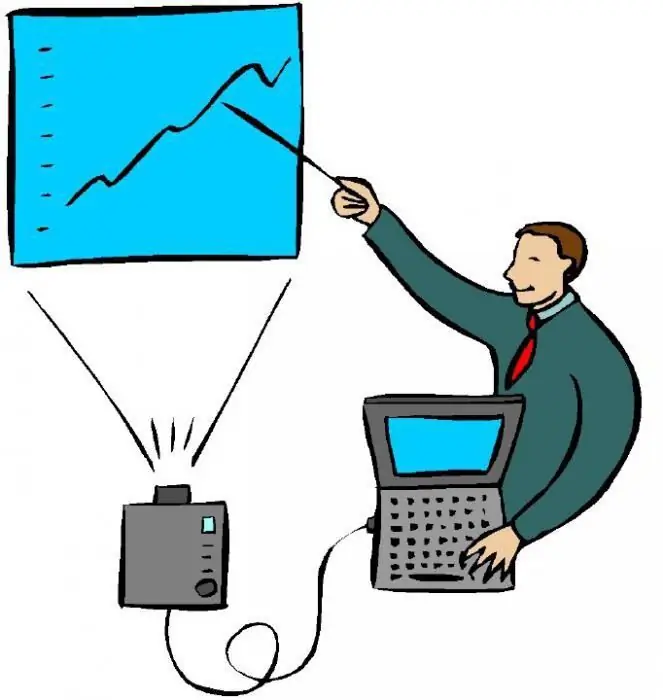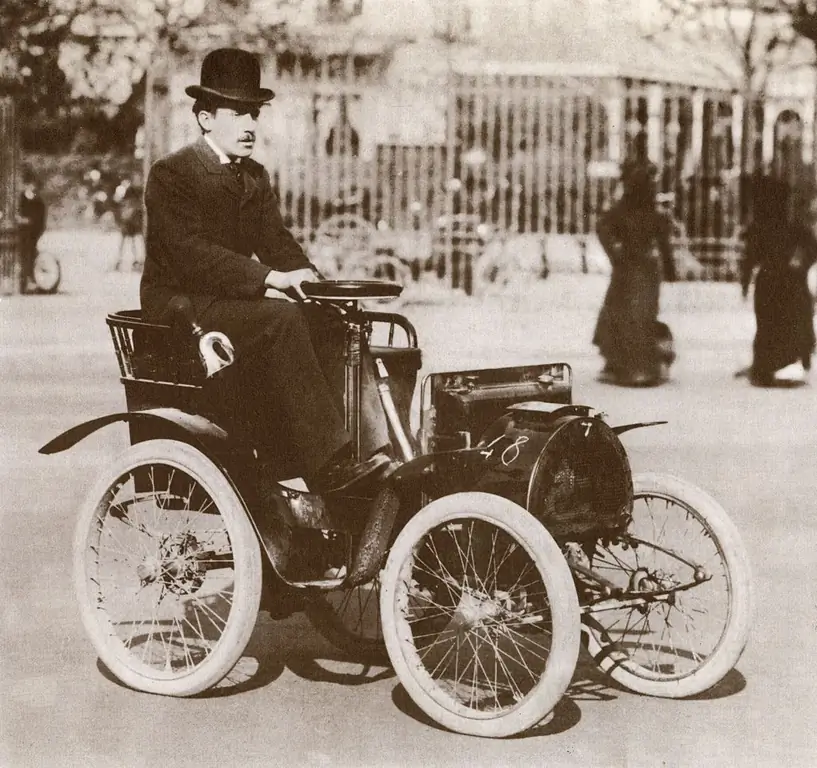2025 Author: Howard Calhoun | [email protected]. Last modified: 2025-01-24 13:10:37
Computer presentation is a special document with multimedia content, the demonstration of which is controlled by the user. At the moment, this is one of the most popular ways of presenting information, which is used in many areas of life.
What is a computer presentation
Quite often, an oral presentation or a written report requires visual accompaniment and visual presentation of information. In this case, a computer presentation can be used. This is a certain sequence of slides or a video sequence. This is a file that contains all the necessary information for a performance.
Basic terminology
Regarding computer presentations, the following terminology is often used:
- interactivity is a property of the presentation, which means the possibility of correcting it with the direct participation of the speaker;
- hyperlink is a slide object that, when clicked, takes you to an external source;
- animation - a dynamic effect that ensures the movement of an object alongslide area;
- project is a schematic description of a future computer presentation;
- multimedia - the use of various kinds of files and effects within one slide.
Types of computer presentations
Despite the fact that this is a fairly common phenomenon, not everyone definitely knows what computer presentations are. So, at the moment, the following main types are distinguished:
- slide presentations are classified as static, because they show a still image that can only be changed through certain user actions;
- streaming (dynamic) presentations are sets of frames that change on their own after a period of time lasting less than one second.
Such concepts as interactive and scripted presentations can also be distinguished. In the first case, the speaker actively interacts with the computer device in order to search for relevant information. If we talk about the script, then we are talking about a clear sequence of slides that change after a certain period of time.

What is a slide
Slides are frames that contain information necessary for a presentation. It is worth noting that it is not recommended to overload them with an abundance of information. The viewer should spend a minimum of time identifying and analyzing the data presented on the slide. That is why it is worth including only the main excerpts andnecessary demo material.
Slides can contain the following information:
- headings and subheadings that have data about the contents of the file;
- graphic images (pictures, photographs, graphs, charts, etc.);
- tables with numerical or textual data;
- soundtrack;
- text file;
- bulleted or numbered lists with data enumeration;
- background image that facilitates the perception of information or has an aesthetic function;
- headers and footers (contain numbering, footnotes or other additional data);
- hyperlinks to external objects.
Development Guidelines
A computer presentation is a visual accompaniment of a text report containing visual information. To make it better perceived, you need to be guided by the following recommendations:
- use short sentences and easy to understand words;
- should use as few prepositions and introductory words as possible;
- use eye-catching headlines that capture attention and capture the essence of the content;
- it is recommended to place no more than three information objects within one slide;
- under the key points of the report, select separate slides, and do not try to fit all the information into one;
- landscape slides are best viewed;
- key information should be located in the central part of the screen;
- captions for pictures should be under, notover them;
- try to have no more than 8 lines per slide, each containing about 30 characters;
- for good readability of the text, use large sans-serif fonts;
- all slides must be in the same style;
- for color scheme it is better to choose cold tones;
- do not overuse animation effects so that they do not distract attention from the main information.
Creation steps
In order to create high-quality material, they go through the following stages of creating a computer presentation:
- development of the structure of the future information file, as well as the general concept;
- next, a post-slide scenario should be outlined (it will not be final, it may be subject to adjustment);
- adding all the necessary objects (text fragments, pictures, and so on);
- setting animation effects that will accompany the change of slides;
- post-editing and also sorting the slides in order to establish their correct sequence;
- launch and preview.
History of computer presentations
The history of the development of computer presentations can be seen on the example of a software product such as Microsoft Power Point, which is most often used for these purposes. Initially, he bore the name Presenter. The program was created by two students who felt it was time to look for new ways to present information.
Initially the programworked only in black and white, after which its color version was developed. At the same time, a rather weighty tome was published, which contained a detailed guide to using the program. But since this idea turned out to be quite expensive, it was soon discarded.
Over time, the program adapted to different operating systems and received more and more new features. Animation features, hyperlink anchors and much more have appeared. Following the concept of this product, a computer presentation is a document that is perceived as a single collection of slides, and not a collection of individual files.
Scope of computer presentations
Having de alt with what a computer presentation is, it is worth determining the scope of its use. So, it finds application in the following areas:
- submission of material in the educational process;
- placement of control tasks for schoolchildren and students;
- promotional activities for goods and services;
- create albums with photos or other images;
- visual accompaniment of reports;
- other.
How to create a presentation
Computer science presentation is created as follows:
- start Microsoft Power Point program;
- in the window that opens, enter the title and, if necessary, the sub title of the slide;
- add the desired number of slides by executing the command "insert - create slide";
- start the presentation with a special command or keyF5, review it and make adjustments if necessary.

Key development questions
In order for a presentation to have the desired effect, it must have the right objectives. To do this, clear answers are given to the following questions:
- target audience that you plan to impress (not only the form of presenting information, but also the design of the slides depends on this);
- the effect that is planned to be achieved as a result of the speech (sell a product, get a loan, demonstrate an invention, and so on);
- correctly identify the presentation object in order to concentrate on it without being distracted by secondary points;
- identifying key features or factors that the audience should pay attention to;
- best way to share a presentation (on a shared screen or on individual computing devices).
Conclusions
A computer presentation is a set of slides through which a visual accompaniment of an oral or written report is carried out. This allows you to improve the perception of information through the presentation of key points. The demonstration of the presentation can be carried out on a common screen, using a projector, or on individual computer devices.
Presentations can be slides or streams. The second is a continuous video sequence that is broadcast during the report. As for slide presentations, they can have a clearscript with automatic change, and can be interactive. This means that the speaker independently searches for information and regulates the change of frames on the screen.
A slide is the main element of a presentation. It contains information such as headers, footers, text snippets, pictures, tables, and other information. In order for information to be perceived in the best possible way, a number of requirements are put forward for slides. So, it is not recommended to place more than three objects, and there should be a maximum of 8 lines of text. It is better to use cold shades of the background, since they are not so irritating to the eyes.
Before you start creating a presentation, you first need to outline the structure of the slides, as well as the concept that will unite them. It is also worth making a preliminary script, according to which the frames will replace each other. Now you need to add all the necessary elements to the presentation file, and then make the appropriate adjustments. Play the slideshow to make sure they are in the correct sequence.
When developing a presentation, it is important to answer a number of questions. The design will largely depend not only on the purpose and subject of the presentation, but also on the audience to which the report is read. Try to highlight exactly the key factors and the essence of the idea, without overloading the slides with unnecessary and secondary information.
Recommended:
"Renault": manufacturer, history and date of creation, management, country, technical focus, development stages, introduction of modern technologies and car quality

The Renault manufacturer produces high-quality cars that are in demand in many countries of the world. The products were to the taste of Russian motorists. In 2015, the French concern produced the millionth car from the lines of the Russian plant
Self-presentation: about yourself briefly and beautifully. Creative and beautiful self-presentation of the teacher

Today, presenting yourself to others is a daily necessity for each of us. Sometimes our partners are serious business people, sometimes they are casual acquaintances, but regardless of professions and age, we all would like to make only a positive impression
Diesel submarines: history of creation, boat projects, principle of operation, advantages, disadvantages and stages of development

The idea of creating a submersible moving under water, actually a prototype of a submarine (hereinafter referred to as a submarine), arose long before their actual appearance in the 18th century. There are no exact descriptions of underwater vehicles in numerous legends, nor in the Renaissance genius Leonardo da Vinci
Two-component polyurethane sealant: definition, creation, types and types, characteristics, properties and nuances of application

With long-term and high-quality sealing of seams and cracks, polyurethane two-component sealants have found their wide distribution. They have high deformation and elastic properties, therefore, they can be used as butt sealants in the field of repair and housing construction
HPP-1: history of the power plant, date of creation, capacity, address and stages of development

A museum exposition has been created on the territory of HPP-1, historical events caused its opening. Employees have collected exhibits, documentary collections from the archives with photographs and memoirs of old-timers. Models give an idea of the past of energy production and what it will be like in the future

